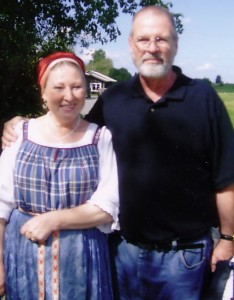 The Kizhi State Museum of Architecture and Cultural History was founded in 1966. The open-air museum is situated in 68 km from Petrozavodsk on Kizhi Island in
The Kizhi State Museum of Architecture and Cultural History was founded in 1966. The open-air museum is situated in 68 km from Petrozavodsk on Kizhi Island in  lake Onega. The core of the architectural collection of 87 buildings is the 22-domed Church of Transfiguration (1714) on photo to the left and the Church of Intercession with the Kizhi Pogost, included in the World Heritage List of UNESCO in 1990. We came there just upon arriving to Petrozavodsk by train and staying overnight in Hotel “Intourist”. On our way we found out that the name of the island itself descends from the Vepsian and Karelian word “kizhat” which means “pagan rites”. The ancestors of the present inhabitants of the Kizhi 9 villages were pioneers from Novgorod the Great. Now return to the Churches. Their design reflects the constructional and architectural wisdom and expedience of many generations of local people. Look at the domes which are covered with silver-colored shingles made of aspen. The carved details serve both decorative and practical needs, they lend special charm to the buildings.
lake Onega. The core of the architectural collection of 87 buildings is the 22-domed Church of Transfiguration (1714) on photo to the left and the Church of Intercession with the Kizhi Pogost, included in the World Heritage List of UNESCO in 1990. We came there just upon arriving to Petrozavodsk by train and staying overnight in Hotel “Intourist”. On our way we found out that the name of the island itself descends from the Vepsian and Karelian word “kizhat” which means “pagan rites”. The ancestors of the present inhabitants of the Kizhi 9 villages were pioneers from Novgorod the Great. Now return to the Churches. Their design reflects the constructional and architectural wisdom and expedience of many generations of local people. Look at the domes which are covered with silver-colored shingles made of aspen. The carved details serve both decorative and practical needs, they lend special charm to the buildings.
Kizhi has made a great contribution to the Russian culture by epic folk tales. Thanks to the Russian folklorists P. Rybnikov and A. Gilferding the Kizhi region became widely known as “island of the Russian epos”. Trofim Ryabinin (1801-1885), the founder of the dynasty of the Russian epic tellers was buried in the graveyard of the Kizhi Pogost. Outstanding epic teller – Vasily Shchegolenok lived in Kizhi parish (1831-1899). 
 The churches were not only the center of the parish life but they were also the symbol of the peasant community united by economical, social and family ties. On the eastern shore in the central part of Kizhi Island the village of Yamka is situated. It was first mentioned in Olonezhie Chronicles of 1563. Janko liked those people very much and it seemed that they liked him too. Look at the photos where Janko is with the Russian girls.
The churches were not only the center of the parish life but they were also the symbol of the peasant community united by economical, social and family ties. On the eastern shore in the central part of Kizhi Island the village of Yamka is situated. It was first mentioned in Olonezhie Chronicles of 1563. Janko liked those people very much and it seemed that they liked him too. Look at the photos where Janko is with the Russian girls.
In some peasants’ houses the authentic interiors have been restored true to life. On the top right picture you see Janko inside such a house where the living quarters and utility rooms were united under one roof in the Northern Russia.
 The high and slender bell-tower with its tent-like roof is the most recent structure of the ensemble (1862, rebuilt in 1874.) The belfry has been reconstructed and from there performed a breathtaking bell ringing that Janko even took off his jacket because of heat, listened to the performer so attentively and left back to the boat without jacket. He remembered about his jacket when we were in the open Onega waters. Beauty demands sacrifice, I told and Janko agreed. Listen to this performance yourselves! Kizhi
The high and slender bell-tower with its tent-like roof is the most recent structure of the ensemble (1862, rebuilt in 1874.) The belfry has been reconstructed and from there performed a breathtaking bell ringing that Janko even took off his jacket because of heat, listened to the performer so attentively and left back to the boat without jacket. He remembered about his jacket when we were in the open Onega waters. Beauty demands sacrifice, I told and Janko agreed. Listen to this performance yourselves! Kizhi